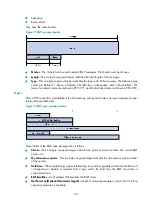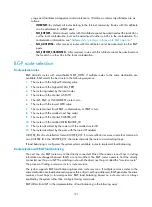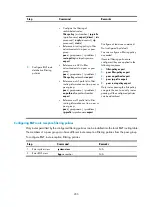
194
In most cases, BGP is used in complex networks, where route changes are more frequent. To solve the
problem caused by route flaps, BGP route dampening is used to suppress unstable routes.
BGP route dampening, as shown in
, uses a penalty value to judge the stability of a route. The
bigger the value, the less stable the route. Each time a route flap occurs, BGP adds a penalty value (1000,
which is a fixed number and cannot be changed) to the route. When the penalty value of the route
exceeds the suppress value, the route is suppressed from being added into the routing table or being
advertised to other BGP peers.
The penalty value of the suppressed route will decrease to half of the suppress value after a period of time.
This period is called "Half-life". When the value decreases to the reusable threshold value, the route is
added into the routing table and advertised to other BGP peers.
Figure 82
BGP route dampening
Peer group
You can organize BGP peers with the same attributes into a group to simplify their configurations.
When a peer joins the peer group, the peer obtains the same configuration as the peer group. If the
configuration of the peer group is changed, the configuration of group members is changed.
When a peer is added into a peer group, the peer has the same route update policy as the peer group
to improve route distribution efficiency.
If an option is configured for both a peer and its peer group, the last configuration takes effect.
Community
A peer group provides each peer with the same policy. A community provides a group of BGP routers in
several ASs with the same policy. Community is a path attribute advertised between BGP peers without
being limited by AS.
A BGP router can modify the COMMUNITY attribute for a route before sending it to other peers.
Besides using well-known COMMUNITY attributes, you can define extended community attributes by
using a community list to define a routing policy.
















































